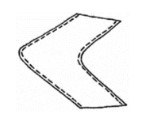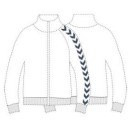Colour change counts: but only if the mark is distinctive enough
The European Union Intellectual Property Office’s (EUIPO) Board of Appeal has upheld a decision in favour of the footwear and sportswear brand Hummel, in a revocation action brought by the exercise brand Barry’s Bootcamp, with use of a black figurative mark on a white background being successfully proven through reliance on evidence which included use of the mark in alternative colour ways.
The background
Hummel Holding A/S (Hummel) owns an international registration for the sign, see figure 1, below, (the sign) designating, inter alia, the EU, where it had been registered for various goods/services since 2006 (the registration).

In 2019, Barry’s Bootcamp Holdings LLC applied to revoke the registration on the basis of non use. In response Hummel submitted over a thousand pages of evidence showing the mark in use in broadly one of three ways:
- use of the sign as registered;
- use of the colour-inverted sign (for example, white chevrons on black bags/socks/balls); and
- use of the sign on a coloured background (for example, on blue bags/yellow socks).
The Cancellation Division held that Hummel had partially succeeded in proving genuine use broadly in respect of sports bags in class 18, clothing, footwear and headgear relating to sports, leisure and fashion in class 25, and balls for sports/games in class 28. Barry’s Bootcamp Holdings appealed.
The appeal
A focus of Barry’s Bootcamp Holding’s appeal was the argument that the simplicity of the sign means that it has a low degree of inherent distinctiveness, such that even minor variations could alter its distinctive character. It relied, inter alia, upon the judgment in Adidas v EUIPO (case T‑307/17) where it was held that inverting the colours of Adidas’ trade mark for three black stripes on a white background altered its distinctive character. In dismissing Barry’s appeal, the Board of Appeal sought to distinguish this case from earlier case law.
In C‑307/11 the Court of Justice of the European Union (CJEU) confirmed that the mark shown below, figure 2, lacked distinctive character, as regards use on shoes, because it could be applied in a decorative way to any part of a shoe, and did not depart from the norms of the sector.

In contrast, the Board of Appeal considered the sign was “considerably” less simple than the mark shown in figure 2; it also has no stitches implying it is intended to decorate shoes or clothing.
The Board of Appeal further noted that in an earlier opposition, filed by Hummel against Barry’s Bootcamp Holdings’ application to register its own chevron mark (R 349/2021-5), Hummel’s marks shown below, figure 3, were all held to have inherent, albeit low, distinctive character.

The Board of Appeal also considered the rejection of the position mark shown below, figure 4, due to it being perceived as a decorative element (R1232/2017-2), but noted that the sign is not a position mark showing a chevron sequence, rather, it is a figurative mark consisting of two identical chevrons.

Finally, the Board of Appeal also considered the mark shown below, figure 5, which was initially rejected for footwear as it was considered to be a basic non-distinctive position mark (R 2604/2017-5), even though it was then accepted as having acquired distinctiveness.

The Board of Appeal contended that the sign, which consists of two identical chevrons characterised by their outline, equal thickness and width, and the equal distance between them, is not as simple as the examples cited.
Accordingly, it held that use of the colour-inverted sign, that is, white chevrons (which maintained the same outlines, thickness and width) on a black background, did not alter the sign’s distinctive character, and that use of the colour-inverted sign therefore constituted genuine use.
With regard to the use of the black chevrons on a coloured background, for example, yellow socks, the Board of Appeal also held these to be acceptable variations of the sign, relying on case law to do so, as the chevrons and their contrast against a light background was maintained.
Comment
Although Hummel ultimately succeeded in this case, it would have been far easier, and cheaper (given the amount of evidence required), had Hummel owned registrations for the colour-inverted sign and/or the chevrons on key coloured backgrounds. Accordingly, this case provides a useful reminder that filing for registered trade mark protection for marks in the form in which they are actually used is strongly advised.
In short
This case confirms that using a registered mark in alternative colours does not necessarily alter its distinctive character such that the use cannot constitute genuine use. However, this only applies if the sign is sufficiently distinctive. To avoid this necessarily subjective assessment and potentially save costs and time, obtaining protection for each form of a mark as used is advised.
Case details at a glance
Jurisdiction: European Union
Decision level: EUIPO Second Board of Appeal
Parties: Barry’s Bootcamp Holdings LLC v Hummel Holding A/S
Citation: R 1422/2022-2
Date: 10 March 2023

